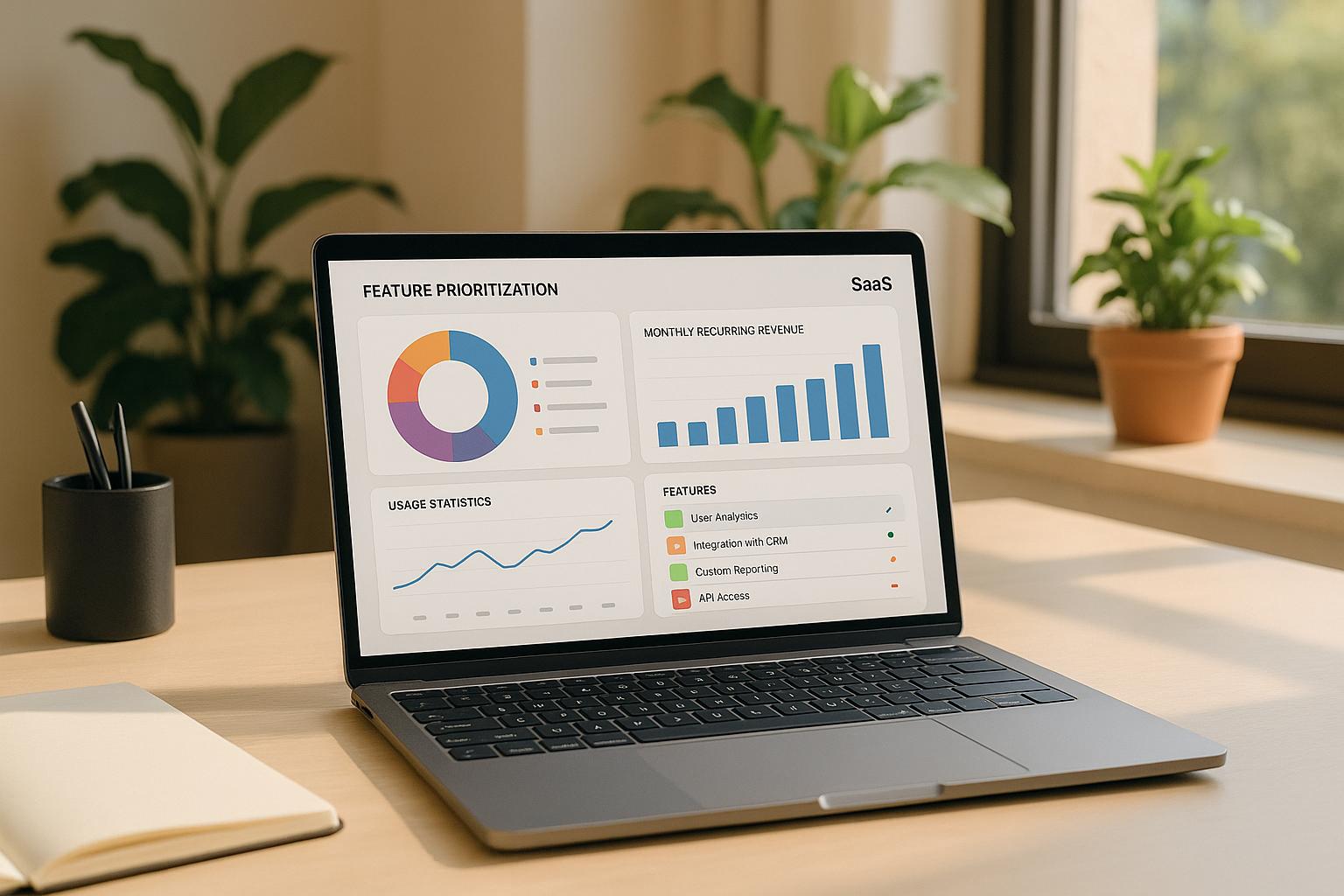Mobile app personalization enhances user experiences by tailoring content, features, and interactions based on individual preferences and behavior. This article highlights 7 powerful tools that can help you achieve that. From real-time recommendations to omnichannel messaging, these platforms are designed to boost engagement and retention.
Key Takeaways:
- Insider: AI-powered real-time personalization with omnichannel support.
- Airship: Advanced journey customization and contextual messaging.
- Braze: Dynamic user journeys and multi-channel engagement.
- Personyze: Behavioral tracking and content recommendations.
- Dynamic Yield: Machine learning-driven product suggestions.
- Bloomreach: Commerce-focused personalization tools.
- Optimizely: Comprehensive testing and real-time decision-making.
Each tool offers unique features like A/B testing, CRM integrations, and user segmentation. Whether you're a small startup or an enterprise, these options cater to various needs and budgets.
Quick Comparison Table
| Tool | Key Features | Pricing Model | Best For |
|---|---|---|---|
| Insider | Predictive analytics, omnichannel support | Custom pricing | Data-driven personalization |
| Airship | Journey customization, push notifications | Starts at $1,200/month | Messaging-focused apps |
| Braze | Real-time data streaming, Canvas builder | $50,000+/year | Enterprise-scale apps |
| Personyze | Behavioral triggers, content recommendations | From $300/month | Smaller teams, quick setup |
| Dynamic Yield | Experience optimization, AI recommendations | Custom pricing | Advanced testing needs |
| Bloomreach | Commerce personalization, search tools | $2,000+/month | E-commerce platforms |
| Optimizely | Multivariate testing, feature flagging | $50,000+/year | Experimentation-heavy apps |
Choose the right tool based on your app's goals, technical resources, and budget. Personalization isn't just a trend - it's a way to keep users engaged and loyal.
1. Insider
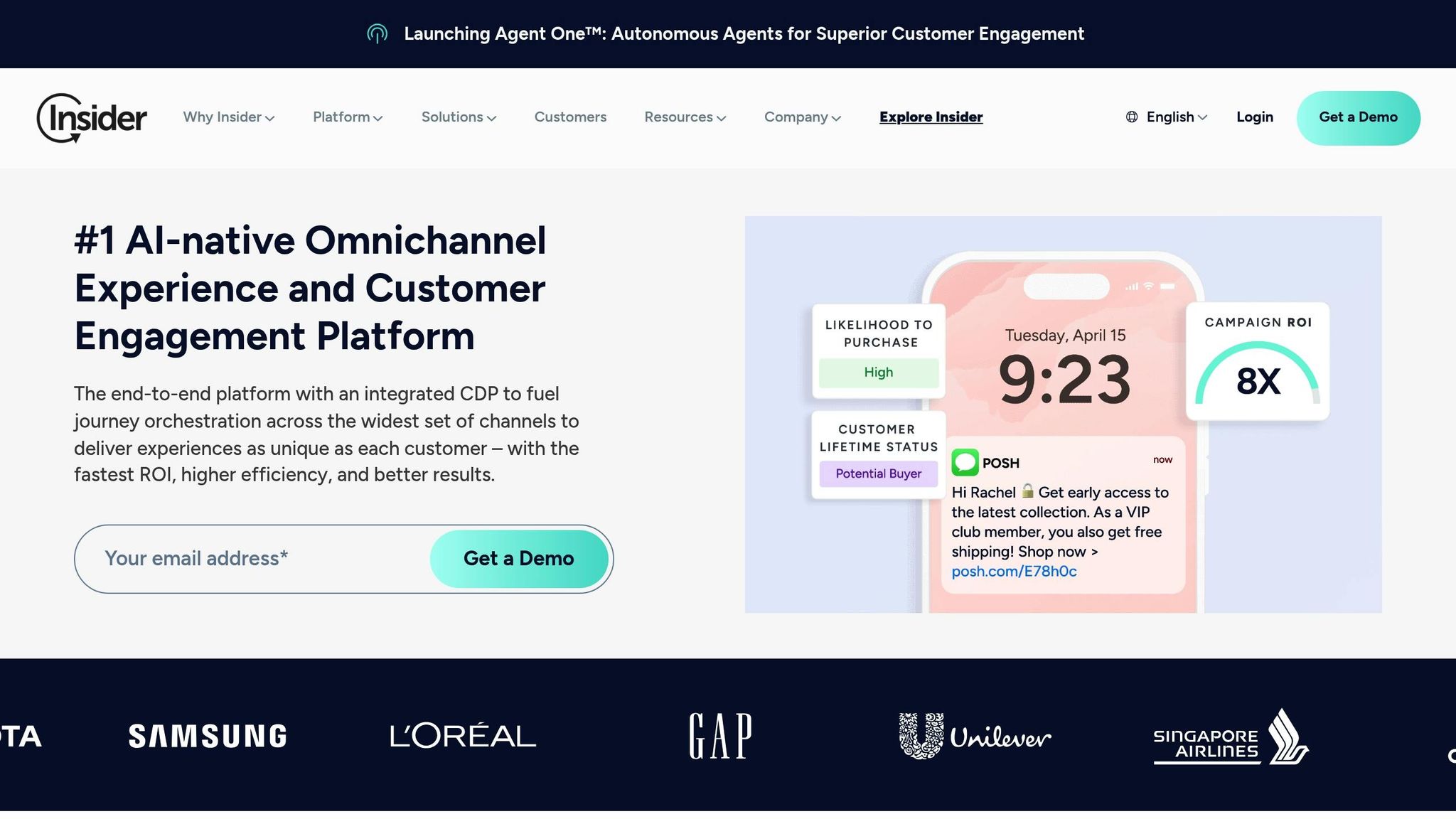
Insider is a personalization platform designed to use AI and customer data to customize mobile app experiences instantly. By processing user data in real time, it dynamically updates user profiles based on how they interact with various features.
Real-time Personalization Capabilities
Insider's AI engine works by analyzing user actions as they happen, such as screen time, taps, purchases, and browsing behavior. This data feeds into machine learning algorithms that predict what each user is likely to engage with next.
Through predictive recommendations, the platform tailors product suggestions, content feeds, and feature visibility to match individual user habits. For mobile apps, this could mean displaying relevant products on the homepage, emphasizing features users are likely to explore, or reorganizing navigation menus to highlight frequently accessed sections. These real-time insights form the backbone of the platform's personalization tools.
Omnichannel Support
Insider doesn’t stop at in-app personalization - it integrates with push notifications, in-app messages, SMS, and email to create a seamless experience across channels. For example, a user's interaction with a push notification can immediately influence what they see when they open the app.
The platform adapts messaging to fit the strengths of each channel. Push notifications might deliver urgent offers, while in-app messages can provide detailed product updates or onboarding instructions. By analyzing user behavior, Insider determines the best channel and timing for communication, ensuring messages are both relevant and timely.
Integration with CRM, CDP, and Analytics Platforms
To provide a complete view of the user, Insider integrates with popular tools like Salesforce, HubSpot, Google Analytics, and Mixpanel. By pulling data from these systems, the platform enriches user profiles with insights from multiple touchpoints.
This means mobile apps can deliver personalized experiences that reflect a user's activity across channels. For instance, if a user browses specific items on a company’s website, they might see related products highlighted when they open the app, creating a smooth, connected experience.
A/B Testing and User Segmentation Support
Insider includes A/B testing tools to refine personalization strategies. Teams can create user segments based on behaviors, demographics, or engagement levels and test different approaches to see what resonates best.
Segmentation options include behavioral triggers like cart abandonments or unengaged push notifications. This level of detail allows for highly targeted personalization, addressing specific user needs and preferences to drive better results.
2. Airship
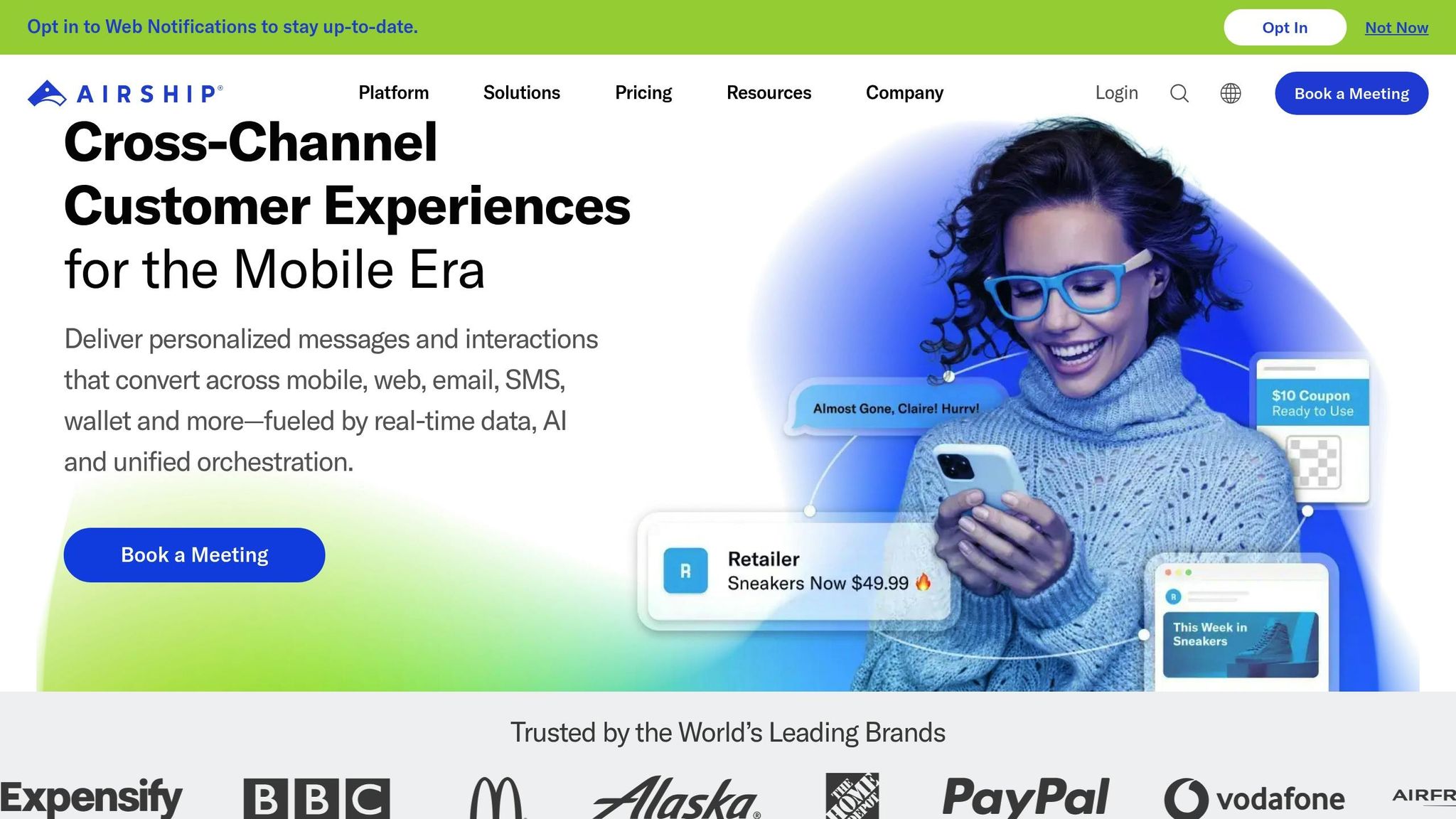
Airship, much like Insider, uses real-time data to create highly personalized mobile experiences. However, it stands out with its advanced journey customization features. By processing user actions in real time, Airship triggers contextual messages and tailors app content dynamically, combining user behavior insights with external data to boost engagement.
Real-Time Personalization Features
Airship’s personalization engine delivers instant, context-aware experiences by analyzing user behavior, preferences, and external data sources. For example, entertainment apps can suggest content based on what a user just watched, while e-commerce apps might showcase products tied to recent browsing activity [2].
The platform’s "Branching" feature dynamically adjusts user journeys. It can skip irrelevant onboarding steps or modify surveys based on previous responses [3].
With "Custom Views", Airship reuses successful native app elements for a seamless experience. For instance, if a user abandons their shopping cart, the next time they open the app, they’ll see their cart with the saved items intact [3].
Additionally, Airship supports customer-led personalization, allowing users to manage their preferences across app and web platforms without needing any coding skills [1].
Omnichannel Capabilities
Airship provides personalized interactions across multiple channels, including push notifications, in-app messages, SMS, and email. By combining mobile behavior data with opt-in preferences and external data, it triggers context-specific messaging tailored to each channel [1].
- Personalized push notifications show an average 22% increase in direct open rates compared to generic messages. However, overly simplistic personalization, like using a first name, can backfire and reduce performance by up to seven times [2].
- Brands leveraging segmentation see open rates grow by 18%–65%, with purchases from push notifications increasing by 4%–72% [2].
Integration with CRM, CDP, and Analytics Tools
Airship integrates seamlessly with customer relationship management (CRM), customer data platform (CDP), and analytics tools. These integrations help create detailed user profiles by pulling insights from various touchpoints. This ensures that mobile apps deliver consistent and relevant experiences that reflect a user’s entire interaction history with the brand.
A/B Testing and Segmentation Tools
Airship offers robust A/B testing tools paired with AI-driven segmentation to fine-tune personalization strategies. Teams can experiment with different approaches and evaluate their impact on conversion rates [3][4].
Surveys reveal that 40% of users value recommendations based on behavior, while another 40% prefer interest-based personalization [2].
- 34% of users find location-targeted content helpful, yet 62% feel location-based ads from unfamiliar brands are intrusive. Still, 41% are willing to share real-time location data if it clearly benefits them [2].
3. Braze
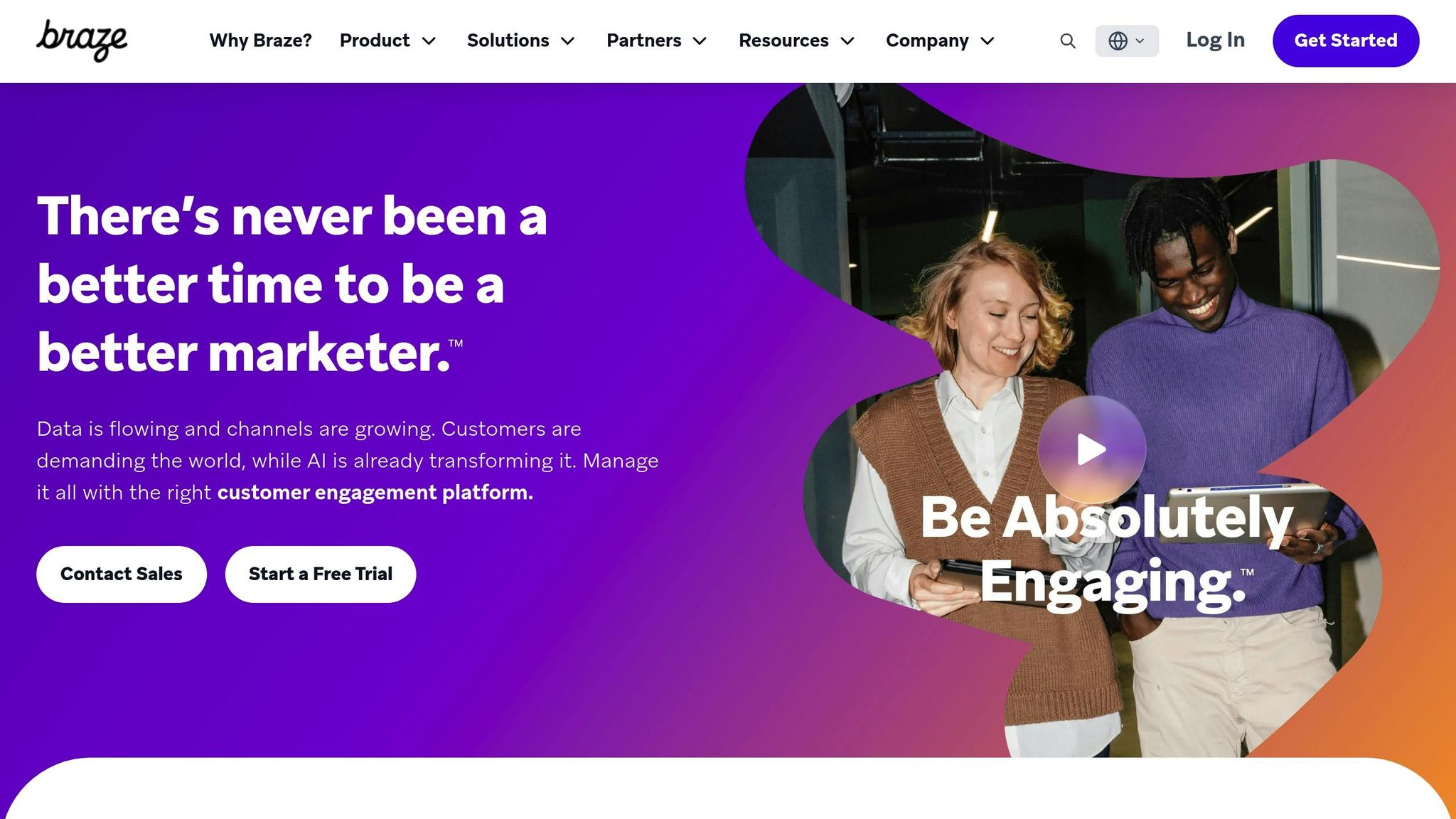
Braze takes customer engagement to the next level by blending real-time data processing with AI-driven personalization. Its standout features include dynamic journey creation and tailored content that keeps users engaged across multiple touchpoints.
Real-Time Personalization Capabilities
One of Braze's key tools, Canvas Flow, builds dynamic customer journeys that adapt instantly. For example, it can send post-workout recovery tips based on real-time activity data. With Liquid templating, Braze pulls in user attributes and external data - like local weather or time of day - to craft messages that go beyond generic browsing recommendations.
Another standout feature is Intelligent Selection, which relies on machine learning to pick the best message variant. It continuously learns from user engagement patterns to refine its choices.
Omnichannel Support
Braze excels at delivering a seamless experience across various channels, including push notifications, in-app messages, SMS, email, and web push. It ensures messages are coordinated across these platforms to avoid overwhelming users.
With Connected Content, Braze can integrate real-time data from external APIs directly into messages. For instance, a travel app could send push notifications with live flight updates, weather conditions at the destination, and even packing tips - all in a single, highly relevant message.
To further enhance user experience, Braze incorporates Frequency Capping and Intelligent Timing features. These tools ensure users receive messages at optimal times and avoid over-messaging, reducing the risk of app uninstalls.
Integration with CRM, CDP, and Analytics Platforms
Braze works seamlessly with major CRM systems, customer data platforms (CDPs), and analytics tools through its Currents feature. This real-time data export capability ensures that user engagement data flows directly into external systems for deeper analysis and better attribution.
The platform also supports server-to-server integrations with tools like Salesforce, Segment, mParticle, and Google Analytics. This integration allows marketing teams to create connected customer experiences, such as triggering personalized app content based on user actions in other channels, like website visits or email interactions.
A/B Testing and User Segmentation Support
Braze simplifies optimization with its Multivariate and A/B Testing suite. Teams can test everything from message content and timing to entire user journey variations. The platform automatically determines the best-performing options, making it easier to refine strategies.
With Audience Sync, Braze enables precise user segmentation by connecting directly to advertising platforms like Facebook and Google. This ensures consistent targeting across both paid and owned channels. Marketers can create detailed segments, such as users who interacted with specific in-app content but haven't made a purchase within a set timeframe.
Braze's Predictive Suite adds another layer of sophistication by using machine learning to identify users likely to churn or convert. This empowers teams to take proactive steps, improving retention and driving revenue growth.
4. Personyze
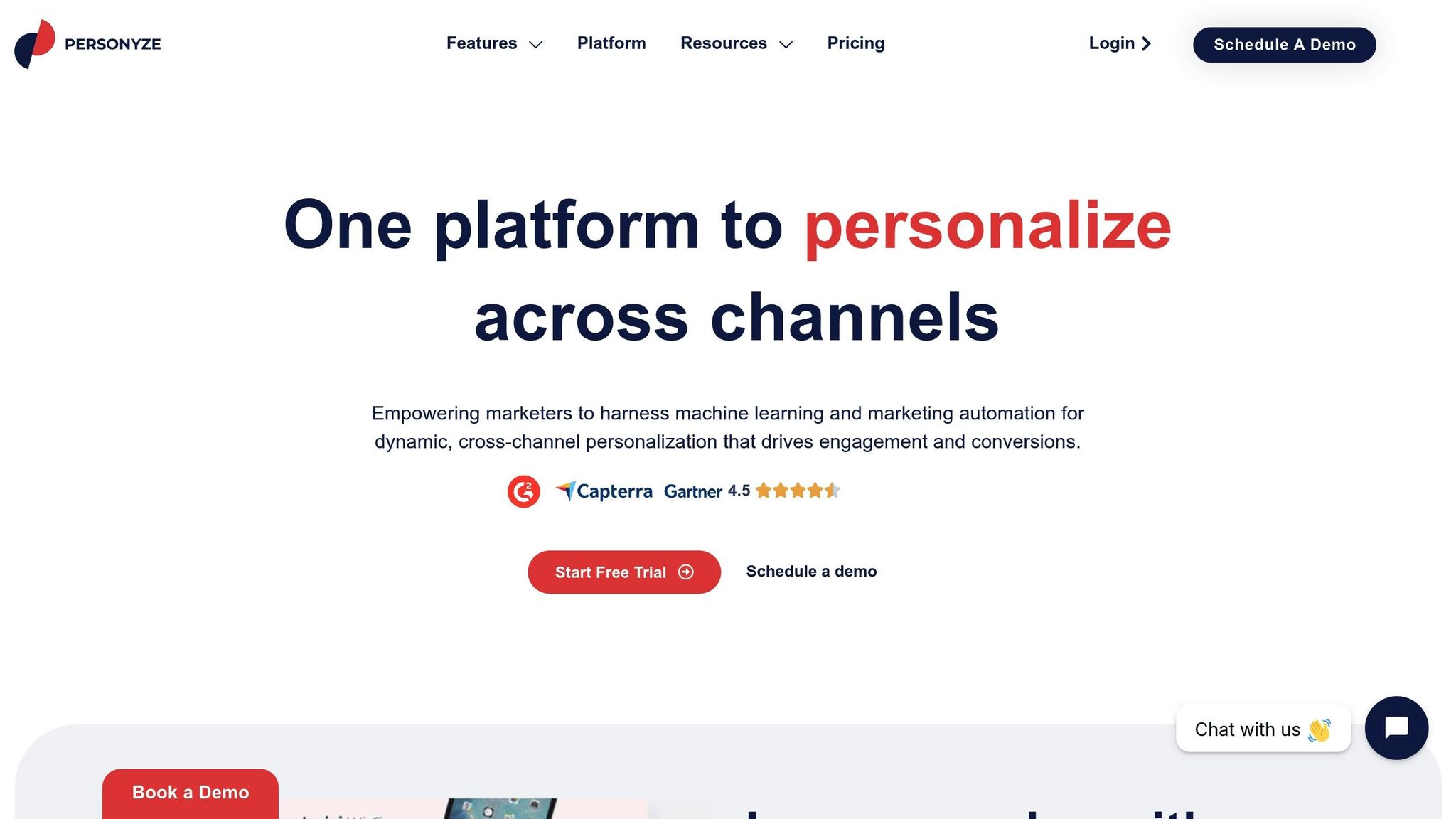
Personyze uses behavioral tracking and machine learning to transform real-time user data into personalized content recommendations.
Real-Time Personalization Features
Personyze's Smart Recommendations Engine analyzes user signals like scroll depth and interaction patterns to deliver tailored content in real time. Its Dynamic Content Optimization adapts app content on the spot, while Behavioral Triggers guide user actions based on their behavior.
Omnichannel Personalization
With Personyze, personalization stays consistent across channels like push notifications, in-app messages, email, and SMS. By unifying user profiles, it ensures seamless messaging. The Cross-Channel Journey Builder automates workflows, and Smart Message Timing fine-tunes when messages are sent for maximum impact.
Seamless Integration with CRM and Analytics Tools
Personyze connects effortlessly with major CRMs and supports APIs and webhooks for real-time data syncing. This ensures your personalization efforts are always based on the latest user data.
Advanced A/B Testing and Segmentation
The platform's Advanced Segmentation Engine groups users dynamically based on behavior and demographics, making it easy to target specific audiences. Meanwhile, multivariate testing allows teams to fine-tune content, delivery timing, and personalization strategies, helping meet the high standards of modern personalization platforms.
5. Dynamic Yield
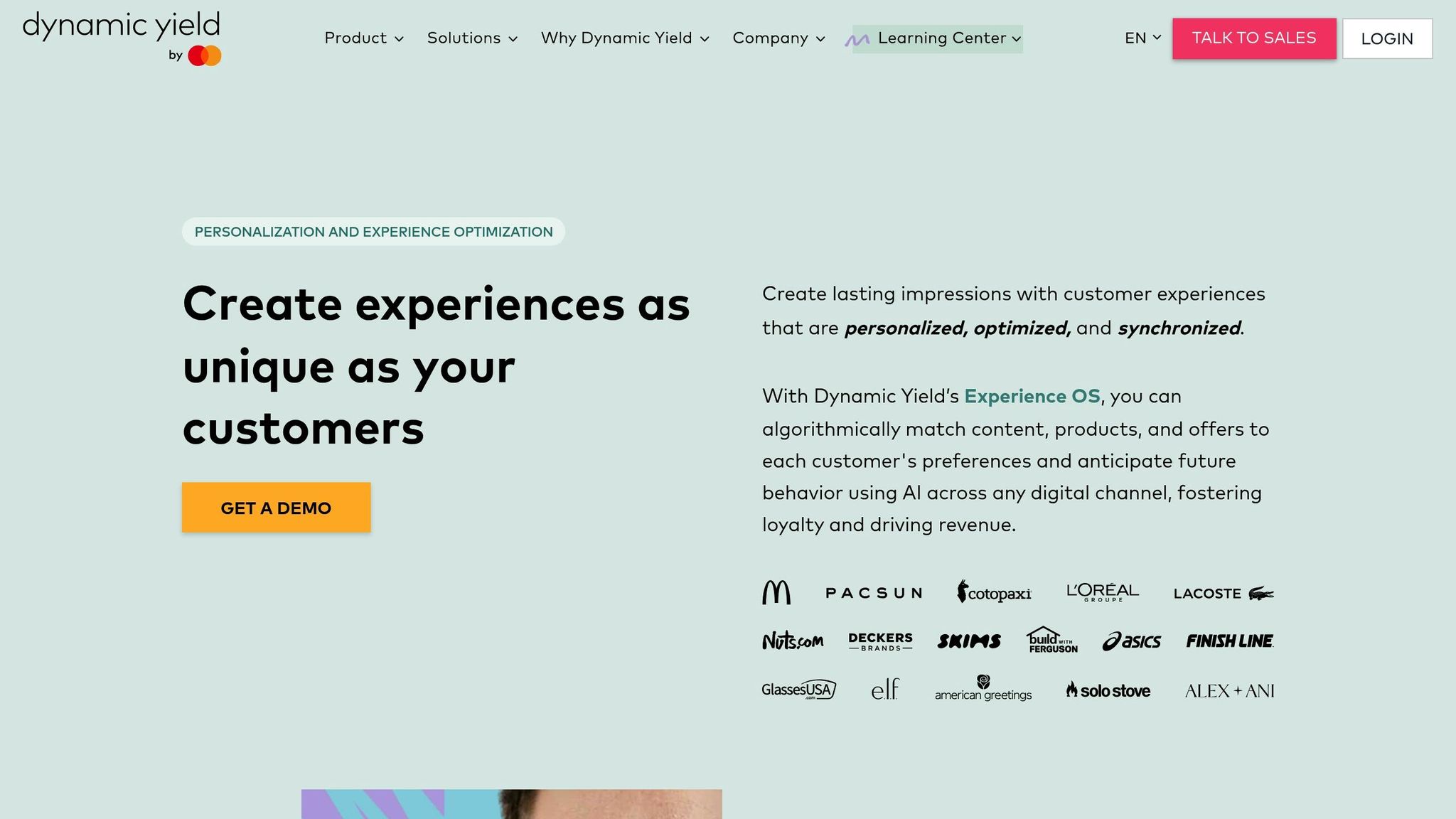
Dynamic Yield uses AI to create personalized experiences that boost engagement and conversions on mobile apps. By combining machine learning with data analysis, it tailors interactions to fit individual user preferences.
Real-Time Personalization Features
Dynamic Yield's Experience OS processes user actions in real time to deliver customized recommendations. Its algorithms analyze data like browsing habits, purchase history, and engagement trends. With Smart Recommendations, the platform uses collaborative filtering and content-based methods to suggest relevant products or content instantly.
The Real-Time Decisioning feature adapts layouts, content, and offers based on user preferences, while the Affinity Engine tracks interests across sessions, continuously refining user profiles for better personalization.
Consistent Personalization Across Channels
Dynamic Yield ensures a seamless experience by maintaining personalization across all platforms. Its Unified Customer Profile consolidates user data into a single, comprehensive view, enabling consistent interactions. Through Cross-Channel Journey Orchestration, it adjusts messaging frequency and content based on user behavior across multiple channels.
Other features like Message Optimization identify the best time and channel for communication, while Content Syndication ensures personalized recommendations stay consistent across mobile apps, emails, and other touchpoints.
Easy Integration with CRM, CDP, and Analytics Tools
Dynamic Yield integrates seamlessly with platforms like Salesforce, HubSpot, and Adobe Experience Platform using pre-built tools and APIs. This allows real-time data synchronization for up-to-date personalization.
Its Data Management Platform combines first-party, second-party, and third-party data to create unified customer profiles. With Real-Time CDP Integration, the system continuously updates user data, ensuring personalization algorithms always work with the latest information.
Advanced A/B Testing and User Segmentation
The platform's Experience Optimization Studio supports A/B and multivariate testing to refine mobile personalization strategies. The Audience Builder creates dynamic user segments based on behaviors, demographics, and engagement patterns, automatically updating as user behavior evolves.
To ensure accuracy, the Statistical Significance Engine validates test results, while Automated Winner Selection deploys successful variations without manual input. Additionally, the Holdout Groups feature measures the effectiveness of personalization by comparing results against control groups, offering clear insights into ROI.
Next, learn how Bloomreach takes mobile personalization to the next level.
sbb-itb-9cd970b
6. Bloomreach

Bloomreach provides tools to personalize content, product recommendations, and user interactions in real time. Using artificial intelligence, it crafts experiences tailored to individual users' needs as they engage with the platform.
Real-Time Personalization Capabilities
Bloomreach continuously updates user profiles based on live interactions. This allows it to adjust layouts, content, and recommendations on the fly, ensuring users receive timely and relevant experiences. Whether it’s tweaking the placement of app content or refining suggestions, the platform adapts dynamically to keep users engaged.
Omnichannel Support (Push, In-App, SMS, Email)
With Bloomreach, businesses can deliver personalized messages across multiple channels, including push notifications, in-app messages, SMS, and email. The platform determines the best channel and timing for each message, reducing the risk of overwhelming users while boosting engagement.
Integration with CRM, CDP, and Analytics Platforms
Bloomreach integrates effortlessly with widely used tools like CRM systems, customer data platforms (CDPs), and analytics platforms. This ensures customer data from various sources is consolidated into unified profiles, creating a clearer picture of each user.
A/B Testing and User Segmentation Support
The platform also includes robust A/B testing and segmentation features. Businesses can experiment with different personalization strategies, comparing results to identify what works best. By dynamically creating user segments based on behavior and demographics, Bloomreach helps optimize key metrics like engagement and conversion rates.
Next, dive into how Optimizely adds to this powerful toolkit.
7. Optimizely
Optimizely is a robust platform designed to help businesses fine-tune their mobile app experiences by using data-backed strategies. It combines powerful tools for experimentation with advanced personalization features, making it an excellent choice for companies aiming to improve app performance. Let’s dive into how its testing framework and personalization options elevate user engagement.
A/B Testing and User Segmentation Support
Optimizely takes A/B testing to the next level with its ability to run complex multivariate tests. These tests allow app teams to compare multiple variations of features, layouts, and content to determine the most effective combinations. This approach ensures that decisions are guided by real-time trends and user preferences.
The platform’s user segmentation tools enable precise targeting by analyzing behavioral patterns, demographics, and real-time interactions. Dynamic segments automatically update based on user activity, ensuring that personalization strategies stay relevant as user behavior evolves.
One standout feature is its statistical significance engine, which delivers reliable test results. This helps businesses make informed decisions, avoiding costly errors when introducing new features or design updates.
Real-Time Personalization Capabilities
Optimizely processes user data on the fly, allowing apps to deliver tailored experiences as users interact with them. Developers can use its feature flagging system to enable or disable personalization for specific user groups, ensuring flexibility and control.
The platform’s real-time decision engine evaluates user history, session behavior, and contextual factors like time and location. This ensures that personalization feels seamless and intuitive rather than forced or overly obvious.
With Optimizely, apps can customize onboarding flows and feature discovery paths. For example, tutorial sequences, navigation patterns, and highlighted features can be adjusted to align with individual user preferences and behaviors, creating a more engaging experience.
Integration with CRM, CDP, and Analytics Platforms
Optimizely’s integration capabilities make it easy to connect with popular CRM, CDP, and analytics platforms through its REST API and SDK. This allows for a two-way flow of data, providing a unified view of user interactions across systems.
Tool Comparison Table
Choosing the right tool depends on your needs, budget, and technical requirements. Below is a comparison of key features, pricing, strengths, and limitations for various platforms.
| Tool | Key Features | Pricing Model | Main Strengths | Notable Limitations |
|---|---|---|---|---|
| Insider | Cross-channel personalization, predictive analytics, real-time segmentation | Custom pricing based on MAU and features | Strong omnichannel capabilities, advanced AI-driven recommendations | Higher cost for smaller apps, complex setup process |
| Airship | Push notifications, in-app messaging, location-based targeting | Starts at $1,200/month for basic plan | Excellent message delivery rates, robust location features | Limited personalization beyond messaging, expensive for startups |
| Braze | Multi-channel campaigns, Canvas journey builder, real-time data streaming | Custom pricing, typically $50,000+ annually | Powerful automation workflows, enterprise-grade scalability | Steep learning curve, requires dedicated team to manage |
| Personyze | Website and mobile personalization, behavioral triggers, content recommendations | Plans from $300/month to enterprise custom pricing | Easy-to-use interface, quick implementation | Limited mobile-specific features, fewer integrations than competitors |
| Dynamic Yield | Experience optimization, product recommendations, A/B testing | Custom pricing based on traffic and features | Advanced machine learning algorithms, comprehensive testing suite | Complex pricing structure, resource-intensive implementation |
| Bloomreach | Commerce personalization, search optimization, email marketing | Custom pricing, typically $2,000+ monthly | Strong e-commerce focus, integrated marketing stack | Primarily designed for retail, may be overkill for non-commerce apps |
| Optimizely | Feature flagging, experimentation platform, statistical analysis | Plans from $50,000+ annually for full platform | Industry-leading A/B testing capabilities, reliable statistical engine | High price point, complex feature set may overwhelm smaller teams |
This table highlights the diversity of options available, from more accessible tools like Personyze (starting at $300/month) to high-end solutions like Braze and Optimizely, which require significant investment. Implementation complexity also varies, with some platforms offering straightforward setups for smaller teams, while others demand substantial resources and expertise.
Feature depth is another key factor. For instance, Dynamic Yield and Optimizely shine in testing and optimization, while Airship specializes in messaging. On the other hand, Bloomreach is tailored for e-commerce, making it less suitable for non-commerce applications.
Your team’s technical skills are critical when making a decision. Advanced platforms provide extensive capabilities but often require significant training and ongoing management. Simpler tools may deliver quicker results but could constrain your personalization capabilities in the long run. This comparison underscores how real-time personalization tools can elevate mobile app user experiences while meeting a wide range of business objectives.
Conclusion
Personalizing mobile apps has shifted from being a nice-to-have to an absolute must for driving growth. It’s not just about making users happier - it’s about keeping them around longer, reducing churn, and turning them into loyal customers. When users feel like the app truly “gets” them with tailored content and recommendations, they’re more likely to stick around, boosting their lifetime value.
When picking a personalization tool, you’ll want to weigh a few key factors: your budget, available technical resources, app goals, and how quickly you need to roll it out. Enterprise-level solutions can be powerful, but they often come with a hefty price tag and require a dedicated team to manage. On the other hand, smaller teams might benefit from tools that are simpler to use, deliver faster results, and offer a better return on investment. For example, e-commerce apps might prioritize tools with shopping-focused features, while messaging apps may need advanced notification options. Some tools demand a lot of setup, while others are ready to go almost immediately - so keep your timelines and resources in mind.
Personalization isn’t a one-and-done task. The best-performing apps are always fine-tuning their strategies, using real user data and feedback to make improvements. It’s important to choose a tool that not only meets your current needs but also grows with your app as it scales.
The bottom line? Focus on your app’s unique goals, user segments, and performance metrics when selecting a tool. A strong personalization strategy - especially one that adapts in real time - keeps your app agile and competitive in today’s fast-moving market.
FAQs
What should I consider when selecting a mobile app personalization tool for my business?
Choosing the right mobile app personalization tool requires a clear understanding of your business goals, audience, and budget. Start by pinpointing your specific needs - do you need a highly flexible solution for long-term growth, or are you looking for a more budget-friendly option that’s quick to set up?
When evaluating tools, focus on a few key areas: scalability, ease of integration, and how well the tool can tailor content based on user behavior and preferences. Don’t forget to factor in the total cost of ownership, including ongoing maintenance and potential upgrades, to make sure it fits your budget and supports your future plans.
What are the main benefits of using AI-driven tools to personalize mobile apps?
AI-powered tools for mobile app personalization bring a lot to the table. They make it possible to deliver tailored content and recommendations, which can turn a standard app experience into something far more engaging and enjoyable. By providing suggestions that are timely and relevant, these tools can build customer loyalty and keep users coming back for more.
On top of that, AI-driven personalization allows for smarter, more intuitive interactions. When users feel like the app truly "gets" them, they’re more likely to feel valued and understood. This not only boosts satisfaction but also improves retention rates and strengthens the bond between users and your app.
How does integrating CRM and analytics platforms improve mobile app personalization?
Integrating CRM platforms with mobile apps brings all your customer data into one place. This makes it easier for businesses to craft experiences tailored to individual users, factoring in their preferences, past purchases, and behavior. The result? More meaningful interactions, happier customers, and deeper engagement.
On the other hand, analytics platforms offer a window into user behavior. They help pinpoint patterns and key moments that matter most to users. With this information, businesses can design customized customer journeys that keep users coming back, enhancing retention and the overall experience.
When you blend the capabilities of CRM and analytics tools, you unlock the power to deliver real-time, personalized interactions. These connections resonate with users and keep them engaged with your app.

